The Creole state has a lot of beautiful natural environments that make it ideal for birds and birders alike. With the Red River valley, the Mississippi Flood Plain, lowlands at the coast and more, you have a lot of lovely places that attract birds and those who love to see them in their natural element. Today we will talk about the popular backyard birds of Louisiana and delve briefly into the when and where aspects of finding them as well as what to look for and what these birds like to eat. Without further ado, let’s get started!
3 Categories – 470 Birds
Louisiana is the part or full time home of an impressive number of bird species. With 470 species being listed for this state the part or full time birder most certainly has a large job ahead of them. For today’s purposes we are going to give you a sampling of birds and divide them up like this:
- Year-round Resident birds
- Birds of Spring, Summer, and Early Fall
- Fall and Winter Birds
We’ll follow this up with a quick list of birds to look for as well as some tips on their favorite foods and where they like to hide when they aren’t spending time in your backyard. Let’s start with the year-round resident birds.
Louisiana’s Year-round Resident birds
The birds that we have listed in this category love the Creole state and are happy to spend all of their time here. This is good news for you as a birder as you can spot them at any time of the year – as long as you know where to look! Let’s see if you can spot one of these Louisiana year-round residents this year:
- Red-bellied Woodpecker
- Tufted Titmouse
- Mourning Dove
- Blue Jay
- Carolima Chickadee
Red-bellied Woodpecker – Melanerpes carolinus

Coloration and Markings: Red-bellied Woodpeckers are quite the lookers. They have zebra-like stripes on their backs, their long wings, and their short, stiff tails. The breast and underbelly of this bird are white with a red wash present throughout, which looks a little like they’ve been splashed with some cranberry juice. Facially, this bird has a mostly white face, with the exceptions a red cap from the front of the bill to the base of the neck and a long straight black bill.
Size: These birds measure in at approximately 9.4 inches from head to tail and have wingspans of 13 to 16.5 inches.
Habitat: These Woodpeckers love the woods and tend to favor Hickory and Oak stands. They range often and can also be found in parks and backyards.
Diet: Suet and chopped apples are an easy and helthy combination that you can leave out to get the attentions of the Red-bellied Woodpecker.
Tufted Titmouse – Baeolophus bicolor
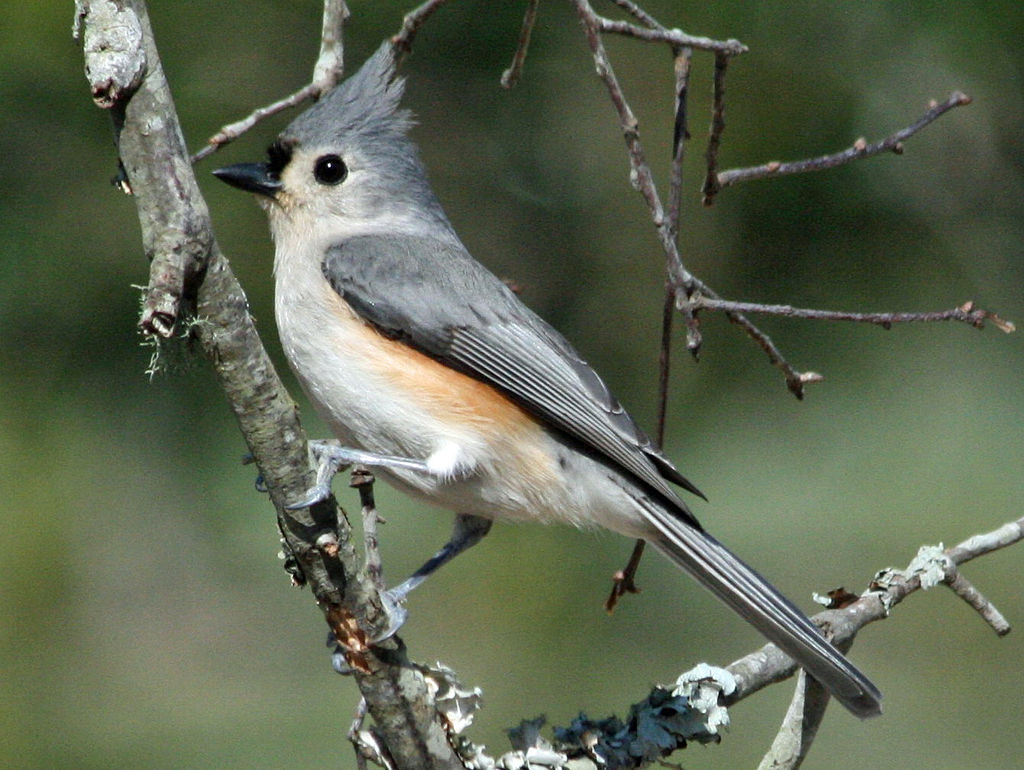
Coloration and Markings: Tufted Titmice have beautiful bluish-gray backs with small bluish, gray wings and long, bluish gray tails which are white on the undersides. They have a white underbelly and breast which bears faints traces of peach coloration at the sides and facially, this bird has a white face on the lower half, which outlines the eyes and cheeks and spreads from the base of the neck to the back of the head. The upper portion of the face is bluish-gray, with a lovely pointed crest and a black, squarish mark on just above the tiny, straight black bill. The upper portion of the bill bears a slight, but noticeable curvature to it.
Size: These birds measure in at 5.5 – 6.3 inches in length and have wingspans of 7.9 to 10.2 inches wide.
Habitat: These birds love deciduous woods and are fond of Evergreens as well. These are bold little birds, so they commonly range into parks, gardens, and backyards.
Diet: Mix up some crunchy peanut butter with suet and you have a perfect teat for the Tufted Titmouse.
Mourning Dove – Zenaida macroura
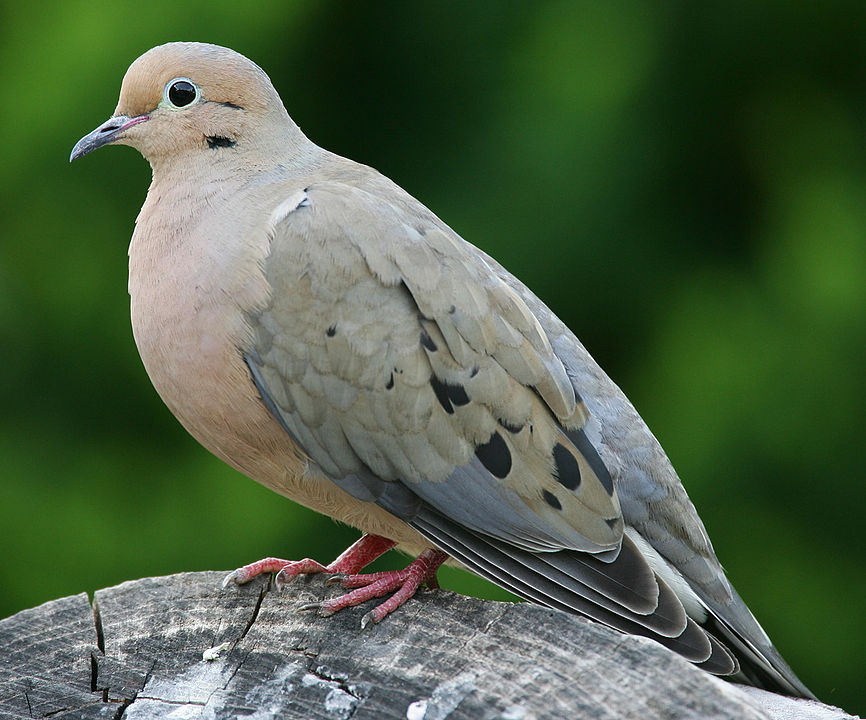
Coloration and Markings: The plump and pretty Mourning Dove is light brown or gray on its back and has long wings of the same color, with the exception of a color addition. Creamy tan coloration saturates the center of the wings as well as some distinct, black spots that are hard to miss. These birds have long, pointy gray tails and gray whites, while the underbelly and breast of this bird are a thick mix of subdued whites and creamy tan colors. The tan coloration is it’s heaviest at the bird’s face, where you will also see a thin, white eyering. This bird has a medium-length, straight black bill.
Size: These birds measure in at 9.1 – 13.4 inches in length and have wingspans of approximately 17.7 inches.
Habitat: Mourning Doves are not interested in the deep woods, though you may sometimes see them at the edges. More often these suburbanized Doves may be on sidewalks, phone lines, or simply standing on a feeder which you have provided as they munch contentedly.
Diet: These birds dine almost exclusively on seeds, so a quick mix of hulled Black Oil Sunflower seeds and Nyjer thistle can get and keep their attentions once they know that it’s in your feeder.
Blue Jay – Cyanocitta cristata
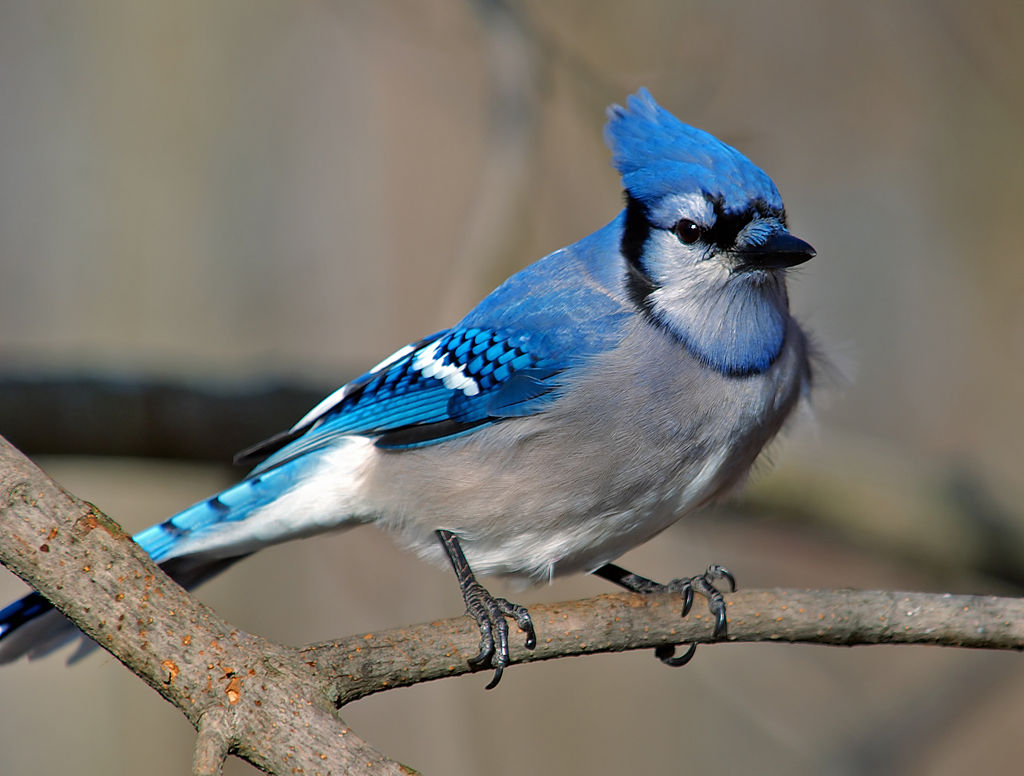
Coloration and Markings: Blue Jays have lovely sapphire blue backs with medium-length wings and long tails. The wings 1 white wingbar each, with scale-patterns of blue outlined with black, while at the lower portion of the wing you can see large white spots outlined in back and this goes nicely with the blue. The tail has more symmetry, however, with patterns of light blue outlined in dark blue in paris going down to the tip. The underside of the tail is white, as is the underbelly and breast of this bird. The white carries on up into the face, where it is interrupted by a black line that travels from the termination of the beautiful blue crest. This line circles around at the base of the throat to the other side of the head. Just below that big, blue crest this bird has a thin, abstract mask that crosses the eye in a somewhat zigzag pattern with the remainder and majority of the face being snowy white. These birds have long, straight black bills.
Size: These birds are hard to miss, with a length from tip to tail of 9.8 – 11.8 inches and a wingspan of 13.4 to 16.9 inches wide.
Habitat: These birds frequent the forest’s edge, however, they do range out often, being bold and curious when it comes to exploration and foraging. It is not uncommon to see them in the city, perched on a fence or a phone line, as the scope out the ground and look for a convenient snack.
Diet: Peanuts or peanut butter along with some suet and a dash of cracked corn may lure the lovely Blue Jay into your backyard so that you can get a closer look or maybe even a picture.
Carolina Chickadee – Poecile carolinensis
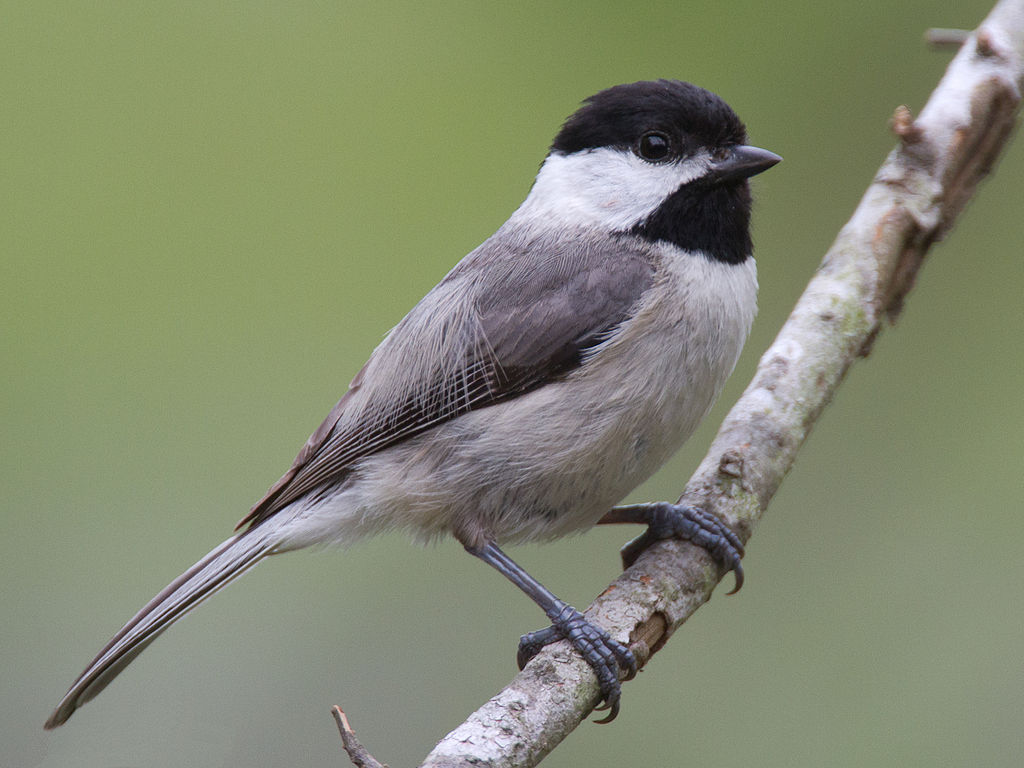
Coloration and Markings: Carolina Chickadees are pretty little birds and easy to identify. They have soft, gray backs with medium-length gray wings which sport the occasional white edging. You will also see a long, gray tail with rounded tips. The breast and underbelly of this bird are white and facially, this bird has white on the center of its face which carries down to the back of the head qand terminates at a level equal to the base of the neck. This bird has a black bib and a large, black cap which terminates at mid-eye level, so that the facial colors are black white black like an oreo cookie. These birds have tiny, conical black bills.
Size: These tiny birds measure in at 3.9 – 4.7 inches in length and have wingspans of 5.9 to 7.9 inches.
Habitat: These birds are equally at home in the woods or the suburbs, often compromising through visits to parks or golf courses where they may forage in inhabited areas.
Diet: Crushed peanuts, suet, and Black Oil Sunflower seeds are 3 easy foods that you can leave out alone or in combination to tempt the Carolina Chickadee into a backyard visit.
Louisiana’s Birds of Spring, Summer, and Early Fall
The earliest signs of spring in Louisiana are often the Maples and Willows, with the former starting to look alive in January and the Maples soon to follow in the next month. Louisiana starts getting greener and greener pretty fast and before you know it a number of birds show up and many of them stick around until early fall. We’ve listed some of those birds below so see if you can spot any of them during the warmer seasons:
- Indigo Bunting
- Purple Martin
- Chimney Sweep
- Painted Bunting
- Orchard Oriole
Indigo Bunting – Passerina cyanea

Coloration and Markings: Male Indigo Buntings are quite striking. They are completely a deep, indigo blue all over their bodies, though you might see a gray feather or two when they are molting. They have medium-length blue wings and which make their small tails look slightly larger and facially you might see some dark blue or black just in front of the eye. This bird has a stout, medium-length, conical silver bill. Females, by contrast, are light brown with some blue tinges throughout the plumage and lighter colored throats. Streaking will be present at the breast and underbelly as well.
Size: These birds measure in at 4.7 – 5.1 inches in in length and have wingspans of 7.5 to 8.7 inches.
Habitat: These Buntings love brambles, thickets, thorns, and shrubs when it comes to foraging, though when singing they prefer the lofty heights of a convenient tree branch.
Diet: Nyjer thistle and hulled Black Oil Suflower seeds are an easy and healthy treat that can catch the attentions of the Indigo Bunting.
Purple Martin – Progne subis
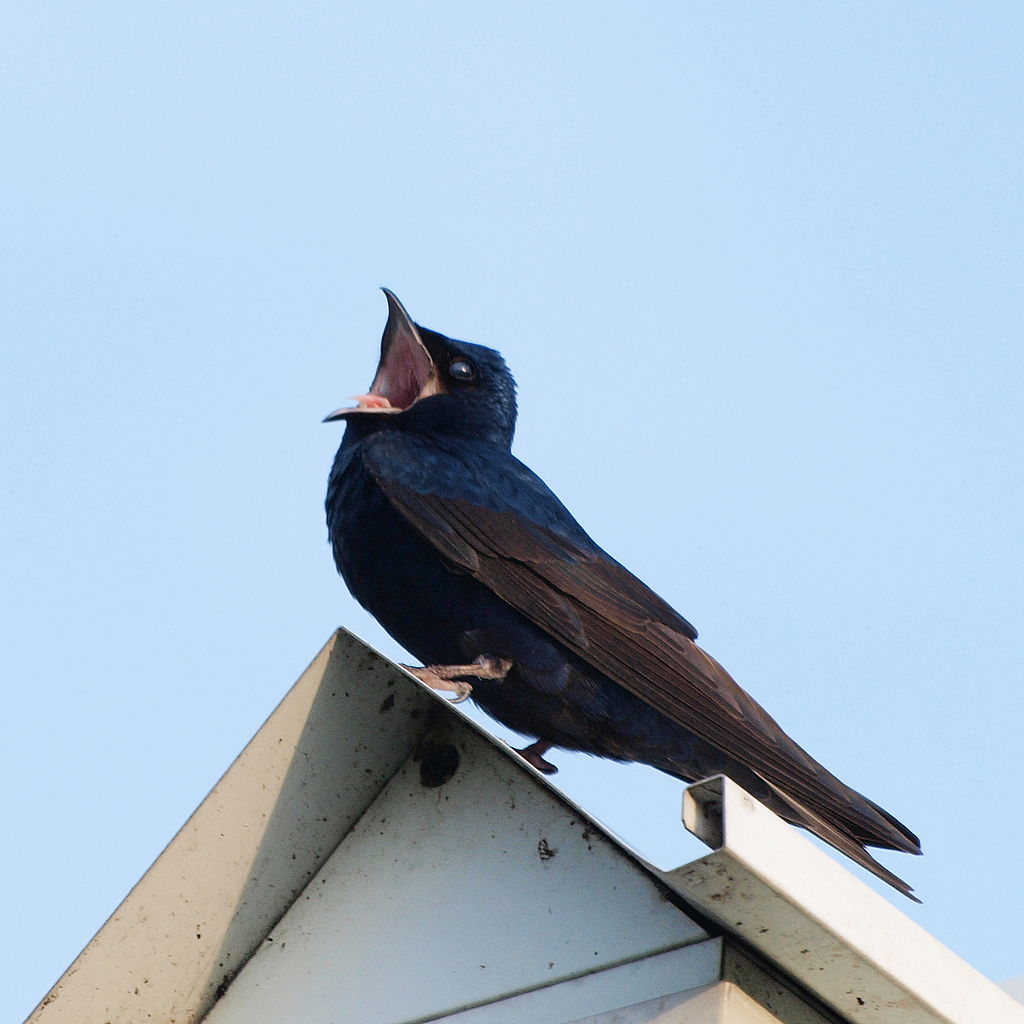
Coloration and Markings: Purple Martins have lovely purple coloration that incorporates spots of black to create a ‘scaled’ look. This purple scaling is present on the back and the shoulder portions of the long, mostly-black wings and these birds have short, forked black tails. The breast and underbelly of this bird also display the purple scaling and the face of this bird is the same, with the scales only broken by the presence of a black half-mask that terminates at the front of the eye and a small, slightly-hooked black bill. Juveniles and females will have more muted coloration and incorporate grays into their plumage. They will also display a lighter underbelly.
Size: These birds measure in at 7.5 – 7.9 inches and have wingspans of 15.3 to 16.1 inches.
Habitat: These birds tend to travel in flocks and prefer open areas, especially those close to water. They are quite receptive to nesting boxes so if you have seen some nearby and want them to consider moving in to your backyard then get that bird house out quickly.
Diet: These birds are almost completely insectivorous, so they will likely ignore the feeder unless you put out some crushed eggshells. The birds ingest these, most likely for reasons of digestion, so you can leave some out and you might just get a closer look at one of these amazing birds.
Chimney Sweep – Chaetura pelagica

Coloration and Markings: Chimney Sweeps are dark grayish-brown on almost all of their bodies but quite easy to recognize. They have long, curved wings and short, stubby tails, and their bodies have a distinctive cigar=shape that is impossible to miss. Their plumage is a lighter off-white just under the eyes and down into the apex of the breast. These birds have small, straight black bills with a slight curvature in the upper bill.
Size: These birds measure in at 4.7 – 5.9 inches in length and have wingspans of 10.6 to 11.8 inches.
Habitat: In the wild these birds tend to nest in tree hollows, caves, and other areas of natural cover, though as the name suggests they do like house chimneys for making their homes.
Diet: These birds eat only insects, so you won’t be able to lure them into your feeder. Don’t worry, though, they are quite easy to spot due to their distinct shape.
Painted Bunting – Passerina ciris

Coloration and Markings: The colorful Painted Bunting has a yellow-green back that turns to reddish orange at the lower back. They have yellow-green wings which will display a little blue at the shoulders and some orange may be present, along with black tips. They have reddish-orange tails of medium length and the breast and underbelly of this bird will be red to red orange. This coloration carries up into the face until just under the bill and terminates horizontals at a level at the base of the throat just behind the cheeks. The remainder of the face is mostly a deep blue, with the exception or a thin, reddish orange eyering and a black half-mask which terminates the front of the eyes. These birds have short, stout, conical silver bills.
Size: These birds measure in at 4.7 – 5.1 inches in length and have wingspans of 9.1 inches.
Habitat: These birds love the forest’s edge but only if there is some dense vegetation present. They love brush, brambles, and shrubs, and you can also look for them in overgrown, weedy fields.
Diet: White Proso millet can lure these birds in but be sure to use a feeder that has a perch for optial comfort while the Painted Bunting dines.
Orchard Oriole – Icterus spurius

Coloration and Markings: Male Orchard Orioles have black backs with some black on their wings at the shoulders, just above a chestnut patch of color, and a little black will be below this as well, with a brownish white set of vertical lines standing out from the black in a shape like a Pan’s flute. The remaining half of the wing it typically grayish and they have medium-length, black tails. The underbelly and breast of this bird will be a rich, chestnut brown and facially, this bird has a black head and this black coloration extends down in a v-shape at the top of the breast. They have long, straight, and sharp-looking light colored or black and white mixed bills. Females will lack the black color but will be largely yellow-green, with 2 distinct white wingbars present on each wing, and juveniles will look the same except for a telltale black around the base of the throat.
Size: These birds measure in at 5.9 – 7.1 inches from head to tail and have wingspans of approximately 9.8 inches.
Habitat: Orchard Orioles love open areas with a scattering of trees present. You can see them at the forest’s edge, in parks, or even in the backyard if you have a few trees back there and your chances go up quite a bit if these are fruiting trees.
Louisiana’s Fall and Winter Birds
With lows around 37 degrees Fahrenheit the winters in Louisiana are quite mild and there are a number of lovely birds out and about just waiting to be spotted. While it’s not brutal out there it is certainly a bit chilly, so be sure to leave a snack or two out in your feeder for one or more of these birds:
- Orange-crowned Warbler
- American Goldfinch
- American Robin
- Hermit Thrush
- Cedar Waxwing
Orange-crowned Warbler – Vermivora celata
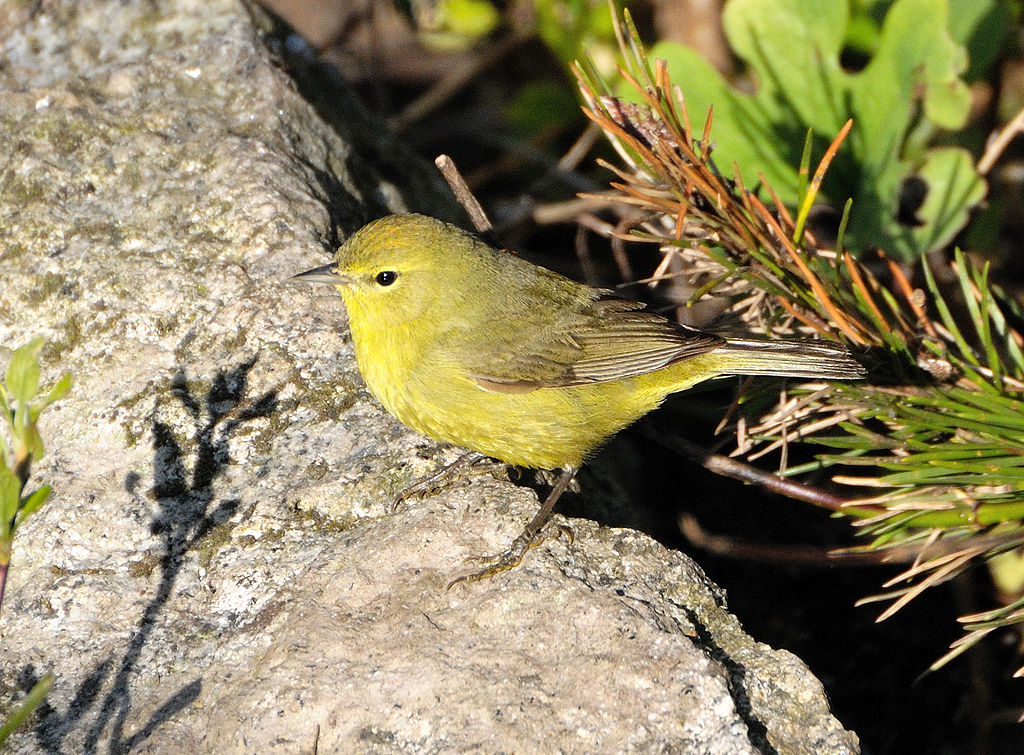
Coloration and Markings: Orange-crowned Warblers have grayish backs with yellow-greens present in the plumage. They have long wings and tails which are the same color, largely gray with yellow-green present in touches and bright yellow may be seen on the undertail. The underbelly and breast of this bird are a mix of white with a heavy saturation of yellow-green and facially, this bird has a gray face with a yellow-green bib and an orange spot on the crown of its head. You may notice a yellow eyebrow line as well and an eyering that is divided horizontally into 2 pieces. These birds have long, thin, and black bills which are straight look quite pointy.
Size: These birds measure in at 4.3 – 5.5 inches in length and have wingspans of approximately 7.5 inches in width.
Habitat: These birds prefer deciduous areas with heavy shrub cover and also have a liking for areas with Oak scrub present.
Diet: You can sometimes attract these Warblers with suet and assorted berries, either fresh or dried. Try some chopped cherries and you might just make a new friend!
American Goldfinch – Spinus tristis

Coloration and Markings: Male American Goldfinches are quite easy to identify. They have bright yellow backs with long, black wings which have 2 white wingbars on each wing as well as vertical white markings towards the center at the rump. They have long, pointing tails which are also black with white markings and though the rump is white, the underbelly and breast will be back to the bright yellow colors of the back. This yellow is also present in the face, with the exceptions of a jaunty black half-cap across the forehead and a medium-length, conical orange bill.
Size: These little guys measure 4.3 – 5.1 inches from tip to tail and have wingspans of 7.5 to 8.7 inches in width.
Habitat: These birds love overgrown fields, especially in areas which are prone to flooding and thus great for foraging. Goldfinches range often, however, so you can also look for them in parks, home gardens, and your own backyard.
Diet: American Goldfinches are easy to please, just leave out a mix of Nyjer thistle and hulled Black Oil Sunflower seeds and once they are noticed you will make a new friend.
American Robin – Turdus migratorius
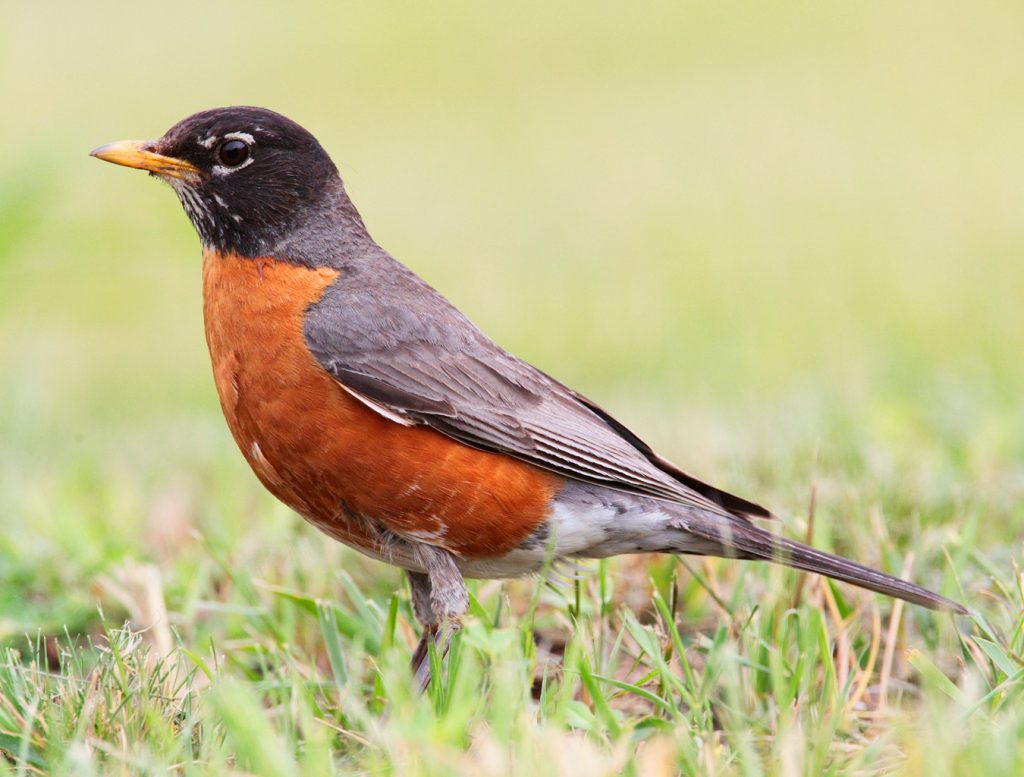
Coloration and Markings: American Robins have grayish-brown backs with long wings of the same color. They have long, gray tails which are often white-edged and this bird also has a white rump. The underbelly and breast of the Robin are a warm reddish orange but facially this bird has an almost completely black head. The exceptions to the black coloration are the birds fragmented white eyering marks and a medium-length, lightly curved yellow bill which sometimes has a touch of black at the tip. Females will have the same coloration, albeit in much more muted, less-contrasting color.
Size: These birds measure in at 7.9 – 11 inches in length and have wingspans of 12.2 to 15.8 inches.
Habitat: These birds love deciduous woods and are often found in pine forests as well. They are comfortable in inhabited areas too, frequenting parks, pastures, gardens, and backyards.
Diet: Chopped apples and live or dried mealworms are an easy and healthy snack that you can leave out for the American Robin.
Hermit Thrush – Catharus guttatus

Coloration and Markings: The Hermit Thrush has a brown back and small, brown wings with some foxy-red coloration towards the wingtips. They have perky, medium-length tails which often bear the same foxy color and the underbelly of this bird is white, while the breast exhibits brown spots on the white and this coloration continues up to the face. The white and spots outline the underside of the cheeks and carry up until under the bill, while the remainder of the face is a light brown with a faint white eyering present. These birds have medium-length, straight bills which are black and yellow.
Size: This bird measures in at 5.5 – 7.1 inches from head to tail and have a wingspan of 9.8 to 11.4 inches.
Habitat: Look for these the Hermit Thrush in meadows, clearings, and at the forest’s edges.
Diet: Nyjer thistle and hulled Black Oil Sunflower seeds can attract and keep the attentions of these lovely Thrushes.
Cedar Waxwing – Bombycilla cedrorum
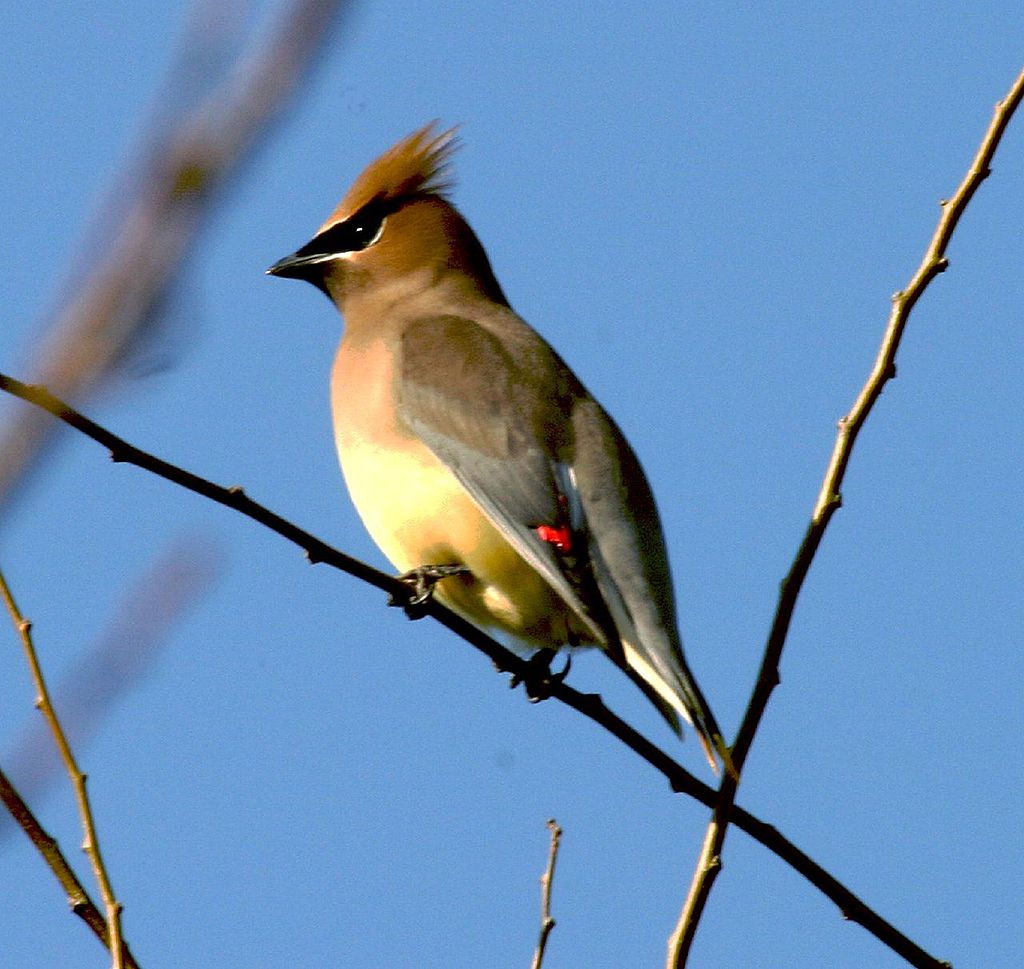
Coloration and Markings: Cedar Waxwings have some interesting color combinations. Their shoulders and the top of the back are a grayish brown, which quickly turns into a soft gray. They have medium-length wings which are gray below the brown shoulder portions with some white edging on the inner wing and just below the wing. Waxy red vertical lines are also present mid-wing, arranged in ascending order like a Pan flute. Waxwings also have short, gray, yellow tipped tails and the breast and underbelly of the bird is a mix of white and yellows. Facially, this bird is a rich, soft brown, and has a large bib/beard type coloration scheme that v’s down into the top of the breast. You will also notice a lovely brown crest and a black mask band, both under and overlined with white, and this band thins as it curves up to stop at the termination of the crest. These birds have thick, short black bills which are straight but the upper bill show a light curvature.
Size: These birds measure in at 5.5 – 6.7 inches in length and have wingspans of approximately 8.7 to 11.8 inches.
Habitat: Cedar Waxwings love the woods but they often range out to visit farms, gardens, and the occasional backyard with a well-stocked feeder.
Diet: These birds are primarily insectivorous, however, they do sometimes supplement their diets with berries. Try adding some chopped up cherries or whole blueberries to your feeder and you might just get the Cedar Waxwing’s attention.
Supporting cast (Other Backyard Birds of Louisiana that might pay you a visit)
While they don’t have the front page, these Supporting Cast birds are celebrities in their own right and you can see them at any time of the year. Add these birds to your ‘watch and lure’ list and see if you can coax them into your backyard with a little thoughtful feeder preparation:
- European Starling
- Northern Mockingbird
- Downy Woodpecker
- American Crow
- Carolina Wren
European Starling – Sturnus vulgaris
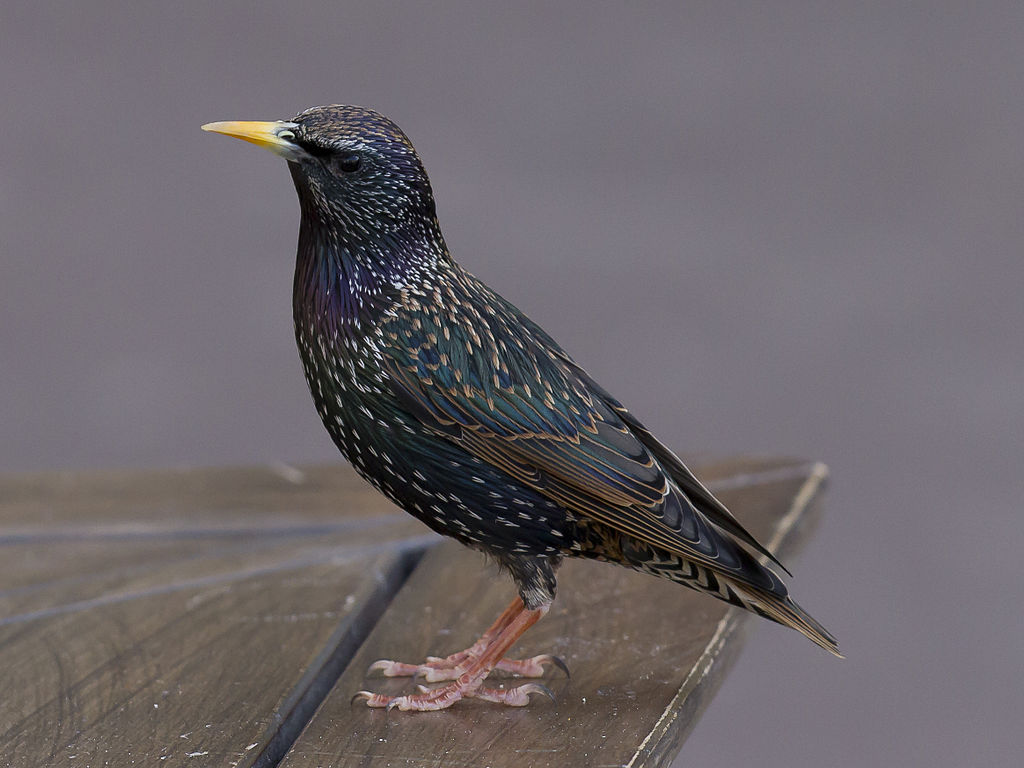
Coloration and Markings: European Starlings look to be black from a distance but their color is actually a combination of purples and greens. This covers them completely and they have long wings and tails and very distinct long, straight yellow bills. In the wintertime these birds shed their shiny plumage in lieu of drab, brown colors with lovely white spots to accentuate. Their winter coats are well worth a look.
Size: These birds measure in at 7.9 – 9.1 inches in length and have wingspans of 12.2 to 15.8 inches.
Habitat: Starlings are most comfortable in areas of human habitation. They are frequent visitors to farms in the country and to towns and cities as well.
Diet: While these birds love suet, they are liable to eat all of it that you’ve got so leave it out sparingly or go with a specialized feeder that can keep these birds out, You can placate them with some wheat and oats and just about anything else that you have around but if you put out suet rest assured that they are going to eat ALL of it.
Northern Mockingbird – Mimus polyglottos

Coloration and Markings: Northern Mockingbirds have soft gray backs and short, broad wings which are gray and dark gray and carry 2 wingbars on each as well as a large, white patch which is mostly only visible when the bird is in flight. They have perky, long tails which are gray with white edges and the breast and underbelly of this bird are a snowy white. Facially, this bird has white cheeks and white is present underneath the bill but if you look closely you can spot a gray mustache line and a grey eyeline which passes the eyes, curls down to frame the cheek, and terminates at that mustache line as if segmenting off the cheekspace. The top and the back of the head are a soft, velvety gray and these birds have medium-length, thin, straight black bills with some minute curvature of the upper bill present.
Size: These birds measure in at 8.3 – 10.2 inches in length and have wingspans of approxijmately 12.2 to 13.8 inches wide.
Habitat: You can spot these birds in fields or at the forest’s edge but you are just as likely to see them around town in gardens, parks, or backyards. Be sure to leave a little something out for these natural mimics as they are beautiful and fun to have around.
Diet: Suet and fruits are the way to go with this bird. Try some chopped up apples or orange slices and see what happens!
Downy Woodpecker – Picoides pubescens
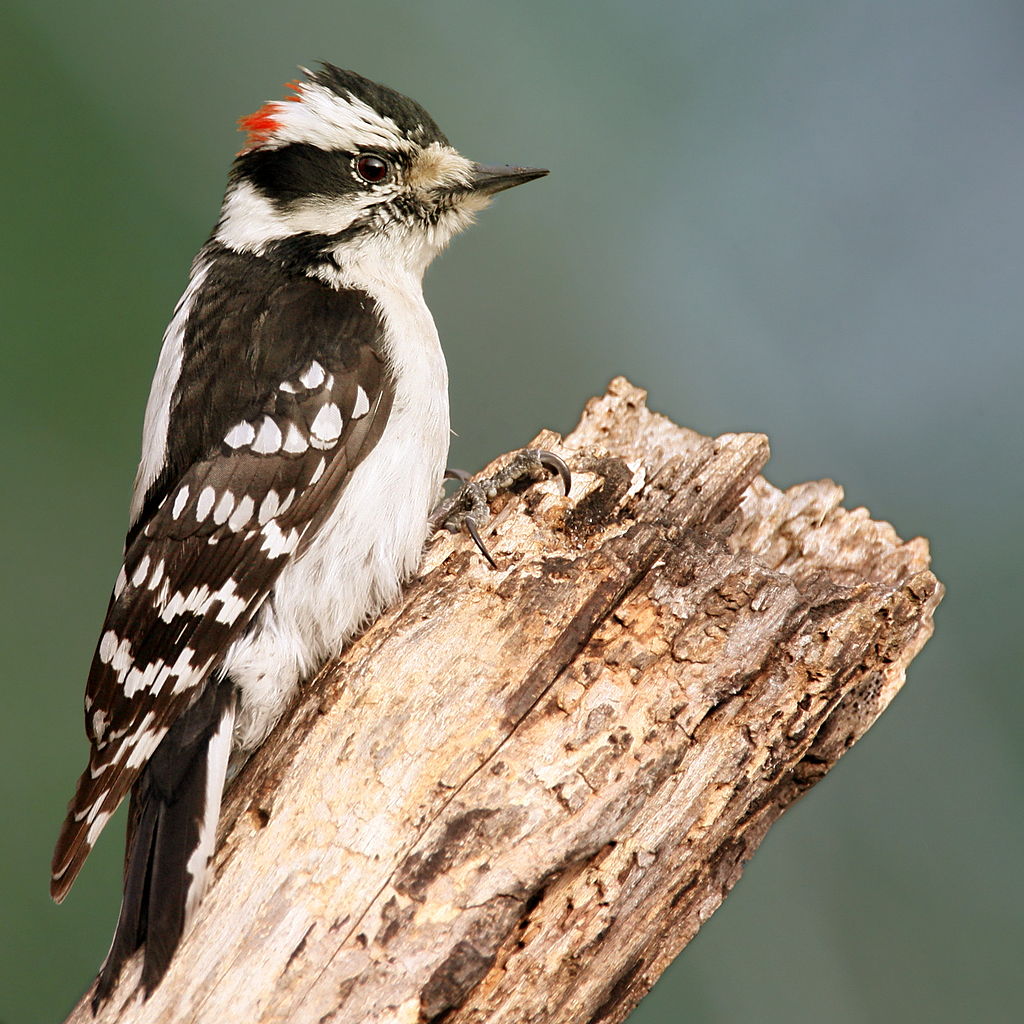
Coloration and Markings: Downy Woodpeckers have a wide white stripe down their backs and ong, lblack wings which bear some striping which is made up of white spots. This has somewhat of a checkerboard look to it that certainly catches the eye. They have short, black tails which are white on the undersides and their breast and underbelly are a snowy white as well. Facially, these birds have white faces with a black mustache line as well as a black mask which goes to the back of the head and a black cap that is solid black in females but terminates at a red spot in the back of the head for males. These birds have thin, straight, medium-length black bills.
Size: These are the smallest North American Woodpeckers, measuring in at 5.5 – 6.7 inches in length and with wingspans of 9.8 – 11.8 inches.
Habitat: These birds love the open woods, especially those of a deciduous variety. They also like to have a little brush cover present as well. You can also see them in parks and their love of fruits attract these birds to orchards as well.
Diet: These Woodpeckers like suet, Black Oil Sunflower seeds, peanut butter, and might even take a sip or two from your Hummingbird feeder.
American Crow – Corvus brachyrhynchos

Coloration and Markings: American Crows are easy to recognize, completely in black and with large wings, long tails, and large, stout, and straight black bills with a noticeable curve on the upper bill. You may notice a little bit of brown on them when winter is getting close as they are molting but aside from this they are quite black, quite distinct, and easy to identify.
Size: These are large birds that measure in at 15.8 – 20.9 inches in length and have wingspans of 33.5 – 39.4 inches in width.
Habitat: While you can find them just about anywhere, when these birds aren’t in fields or at the forest’s edge they spend a lot of time in the city. Look up and you’ll see them on fences and phone lines and they are more than happy to visit your feeder if you leave a little something out for them. You should, common or not, Crows are beautiful, intelligent, and well worth watching.
Diet: These birds will eat just about anything but if you want to leave out something delicious and healthy, try some Pumpkin or Black Oil Sunflower seeds and you’ll have happy, munching Crows.
Carolina Wren – Thryothorus ludovicianus

Coloration and Markings: The Carolina Wren has a warm, reddish-brown color on its back as well as its short wings and long, perky tail. The wings are edged in a minute black and white mini-checkerboard patterning and there is also a thin black and white wingbar. The tail is also edged in tiny black and white marks while the breast and underbelly of this bird are a yellow-orange color. Facially, this bird has white behind the cheeks as well as a white chin and a white eyebrow line. A brown mask is also present which goes to the back of the head and the top of this bird’s head is brown as well. This bird has a long, slightly curved black bill.
Size: These Wrens measure in at 4.7 – 5.5 inches in length and have wingspans of approximately 11.4 inches in width.
Habitat: These are birds of brushes, brambles, thickets, shrubs, and thorns. If there is dense vegetation about then you can find the Carolina Wren.
Diet: Black Oil Sunflower seeds, suet, and any berry that you have around can be added into the feeder to make the Carolina Wren very happy.
Louisiana Bird Buffet
When you are trying to set up that perfect feeder for luring in the most diverse and interesting new birds it can be hard to decide what to put out. We’re sharing some suggestions today from LouisianaBirds website and adding a few of our so that you can get started on finding that perfect combination to lure the birds that you want to see. Be sure to check the references below if you would like to see more of LouisianaBirds recommendations, as they also include some general feeder information as well which you might find useful. In the meantime, make sure that your feeders have one or all of the following:
- Safflower seeds
- Black Oil Sunflower sedds
- Nyjer Thistle
- Suet
- Crunchy peanut butter
Louisiana Birding Hot Spots
When you are out and about and have a little time for yourself, why not get those binoculars handy and pack up a light ice chest of snack and get out into the wild? You can find some of the birds that you love while enjoying beautiful scenery and even take pictures of your favorite winged stars like a true Chirparazzo. We’ve selected some locations at the compass points and central Louisiana but if you don’t find something close you can always check our reference link below. So, what are you waiting for? See if you can visit one of these parks or trails:
- Northern hotspot – Rock Island Greenway
- Eastern hotspot – Tammany Trace
- Southern hotspot – Lake Martin Levee Trail
- Western hotspot – Little Cyprus Pond Loop
- Central hotspot – Baton Rouge Levee Bike Path
Detailed descriptions of each location as well as information regarding visiting and what birds you can see at these locations may be found at https://www.traillink.com/stateactivity/la-birding-trails/
Well. That’s all, folks!
We hope that you have enjoyed our article today on the popular backyard birds of Louisiana. As you can see with over 470 different species of bird you are going to have a busy and very interesting time as a birder in the Pelican state. Just be sure to bring your binoculars and your camera if you decide to visit one of the hotspots that we have listed but most important of all, bring your patience. These little angels are beautiful but all know that they can be very, very shy. Until next time, we wish you Happy Birding!
